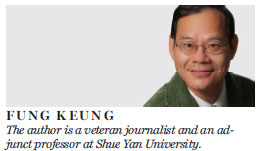Anti-suicide efforts should focus on deprived districts
Updated: 2015-03-23 07:28
By Fung Keung(HK Edition)
|
|||||||
For the first time in Hong Kong's history, a scientific study has determined that the suicide rate of deprived areas in Hong Kong, including Shum Shui Po and Kowloon City, can be twice as high as in other districts.
Armed with these findings the SAR government would be well advised to allocate further resources to these areas and prevent suicides.
The research was carried out by two Hong Kong and two Taiwan scholars including Paul Yip of Hong Kong University, an expert on suicide. The findings were published in the March issue of the well-respected Journal of Social Science and Medicine. To the best of the researchers' knowledge, this is the first detailed small-area analysis of suicide in an Asian city.
In summary, their research reveals that the geographic distribution of suicide shows distinct patterns in Hong Kong.
High suicide rates were found in areas that are both densely populated and deprived. Suicide rates are also associated with deprivation and social fragmentation. Suicide rates in the most deprived areas such as Shum Shui Po, Wong Tai Sin and Kowloon City are 2.3 times higher than in least deprived areas.
About 6,000 people committed suicide in Hong Kong between 2005 and 2010. I am sure there is more the government could do to prevent suicide.
The research states that the "city center" of Hong Kong, a generally non-deprived area, shows mostly below average suicide rates. However, there are high rates concentrating in some socioeconomically deprived, densely populated areas. It says there are greater geographic variations in suicide rates for males than there are for females - except for among the elderly age group. The research finds that suicide rates are associated with indicators of socioeconomic deprivation (populations with non-professional jobs and low median household incomes), and social fragmentation (proportions of unmarried adults and divorced/separated adults).
Gender and age groupings have different associations with suicide rates, the research reveals. Areas in the most deprived quintile have a suicide rate more than twice as high as the least deprived, the research shows. It notes that the association between suicide and deprivation is stronger in males than females and more marked among the youth when compared with the elderly.
The spatial distribution of suicide in Hong Kong shows distinct patterns and a stronger association with incomes compared to findings from Western countries, the scholars suggest. They add that suicide prevention strategies (perhaps led by government officials) should consider tackling the marked socioeconomic gradient in suicide and high risk of suicide among young and middle-aged males living in deprived areas.
The study finds that high suicide rates appear in clusters in some inner city areas of Hong Kong Island (near North Point) and Kowloon (Sham Shui Po, Wong Tai Sin, Kowloon City and Kwun Tong). The highest suicide rates are in Sham Shui Po and Kowloon City (both in Kowloon), the study finds.
In males in the 10 to 44 and 45 to 64 age groups, suicide rates in the most deprived areas are more than three times higher than the least deprived areas, the study reveals.
Based on these findings, perhaps the Hong Kong government should target young and middle-aged men living in deprived areas of Hong Kong including Shum Shui Po and Kowloon City, which show a particularly high rate of people at risk of committing suicide. The scholars suggest programs supporting education and work opportunities in this group could be considered. "We should also consider how to make good use of resources within the community to help vulnerable members of the community," the scholars recommended.

(HK Edition 03/23/2015 page9)